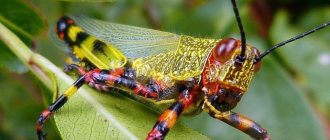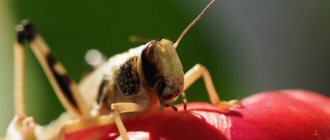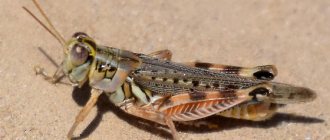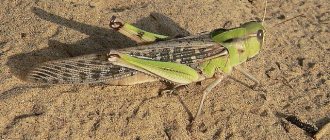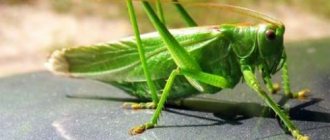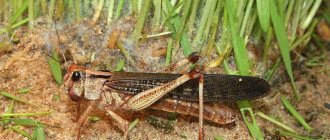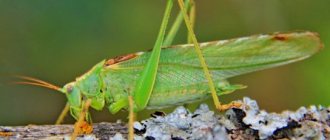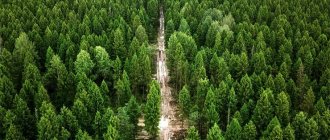Biological cycle of locusts and forms of life activity
- Fact:
During the mating season, the male insect begins to secrete a special substance, a hormone, to attract a female. - Fact 2:
If there is an abundance of food all year, then locusts will also breed all year round. - Fact 3:
Locusts are a global disaster. It is called the “green plague” and there are even special organizations that are constantly working on finding means to combat the pest and leading this very fight. - Fact 4:
Many southern states have found their own way to “take revenge” on the harmful insect. It is eaten and even considered a delicacy.
The “gray catastrophe” or locust plagues have been known since ancient Egyptian times. Herds of chirping insects do not disdain anything, including human clothing, furniture and buildings with thatched roofs. What can we say about fields, orchards and vegetable gardens? Swarming clouds roll in like huge waves of a menacing ocean before a storm. As soon as one herd, having eaten to its fill, rises from its place, another immediately lands in its place. And so on until there is nothing edible for the insect left on the surface.
Locust breeding
In comfortable conditions, after mating, females lay eggs in moist soil, either waiting for rain or choosing places near water bodies. The incubation period does not last long, on average about two weeks, the larvae hatch, which have to feed on abundant plant food after the rains for about a month and a half until they are completely transformed into an adult capable of opening their wings. From this moment the young are ready to fly.
The fate of each individual may be different:
- Singles - appear under favorable conditions and the presence of large free space.
- Members of small flocks make small joint flights in the same habitat.
- Migrants - when there is a very large concentration of individuals, they create a huge flock that covers incredible spaces during the flight and devours all possible plant food at the landing site.
Description of the insect
The locust's body is elongated, from 5 to 20 cm long , with bent hind legs, which are much longer than the front legs. The insect has hard elytra that cover the barely visible transparent wings. The wings are sometimes covered with various patterns. Locusts have small antennae that are smaller than those of a cricket or grasshopper.
Her head is big and her eyes too. The locust makes a characteristic sound, reminiscent of chirping, it is produced in a similar way: males have special notches that are located on the thighs, and they also have thickenings on the elytra. When these parts rub, a sound of different tones appears. It flies very quickly: a flock of insects can fly about 120 kilometers in a day.
The color of an insect does not depend on congenital factors ; it is influenced by the environment. Individuals from the same offspring, but living in different conditions, may have different colors. In addition, the color depends on the locust's lifestyle. For example, if a female or male leads a solitary existence, then its color may be green, gray, yellow or brown. Also during this period they have pronounced gender differences. When an insect switches to a gregarious lifestyle, it becomes the same as everyone else, and sexual dimorphism disappears. Photo of locusts:
Types of locusts
There are quite a few types of locusts, since they easily take root in a new area, immediately adapting to it; even in Russia, the filly lives and thrives - a peaceful solitary locust that does not flock into swarms.
The most dangerous for agriculture are two subspecies of migratory locusts : the Asian one, which causes enormous damage to cereal crops, and the Central Russian one, which is more adapted to the cold. But, of course, the true scourge of agriculture are two species: the Turanian locust and the Moroccan locust.
The Moroccan locust, reaching 4 centimeters and distinguished by its red-golden color and bright red shins, has settled over a vast territory from Southern Europe to Kazakhstan. Locusts cause irreparable damage to cereals and garden crops. The larvae destroy plants completely; adult locusts devastate hectares of crops, simply gnawing plants at the roots. The Turanian locust terrorizes the population in northern China, Afghanistan, the southern regions of Kazakhstan and Central Asia.
The worst thing is the hybrids: new species born as a result of such mating can inherit the gluttony and gregariousness of the southern locusts and combine them with the resistance to frost of the northern fillies, which will allow them to avoid migration and actively devastate the northern lands.
And
Although the speed of locusts is not the highest in the insect world - only 10 km, swarms actively take advantage of the tailwind, which allows them to fly thousands of kilometers.
One swarm of locusts can include up to 50 billion individuals, and in a day such a swarm can devour four times more plants by weight than all the food of the inhabitants of a metropolis, such as, for example, New York.
If your favorite rose has spider mites, we recommend using Nissoran. The village tick is a carrier of encephalitis and relapsing fever. Read here what to do to avoid encountering this parasite.
Country tents with mosquito nets will make your holiday pleasant and relaxing. No more annoying flies and mosquitoes! Tips for choosing can be found at https://stopvreditel.ru/parazity/zashhita/setki/sadovyj-shater.html link.
Differences from grasshopper
To an uninformed person, locusts may look like grasshoppers. However, it has considerable differences: the first belongs to the locust family, suborder of the short-whiskered ones, the second belongs to the grasshopper family, suborder of the long-whiskered ones. Other differences:
- The grasshopper has longer whiskers and legs.
- The grasshopper is a predatory insect, the locust is a herbivore. However, there are times when locusts can eat a weakened fellow.
- The locust is active during the day, the grasshopper at night.
- The locust causes enormous damage to agriculture, while the grasshopper is absolutely harmless.
- Locusts lay eggs in the soil or leaves. Grasshoppers lay eggs in the bark of trees or in the stems of plants.
Harm to agriculture
Locusts have been a terrible scourge for farmers since ancient times. The fear of her attack turned ordinary insects into divine punishment and almost a harbinger of the end of the world.
Time passes, but nothing changes for the locust - it still terrifies with one appearance in the form of a black cloud on the horizon, moving with great speed and the strong noise of billions of wings.
When landing on a field, the flock will not take off until there is at least something green left on the ground, but this food will be enough for it for one day, and the swarm will move on.
Locust plagues can deprive up to several million people of food and occur every 10–20 years when, due to excellent weather conditions, larvae are born in abundance and the swarm faces starvation in its usual habitat.
Fighting methods
- Pesticides – allow you to kill locusts the moment they land to feed. A method that loses its effectiveness every year, as new generations are born with resistance to poison. And land contaminated with poison cannot be used for a long time.
- Noise - since ancient times, when locusts approached, people came out into the field with rattles, pots and everything that could make noise. Locusts do not tolerate air vibrations well and usually try to find a quieter place.
- Biopesticide is a fungus that is deadly to locusts. Sprayed onto a flock, the fungus instantly kills insects and retains its properties for a year, so there is no need to fear an invasion for a long time.
Egyptian and Bluewing
The female Egyptian filly is one of the largest species of locust and grows up to 70 mm, the males are somewhat more modest - 30-50 mm. The insect has a gray, light brown and greenish color. The tibiae of the hind legs are blue, the thighs are orange, with dark spots. Locusts' eyes have black and white stripes. The Egyptian filly is found in the Middle East, northern Africa and Europe.
The blue-winged filly is a standard-sized insect with the Latin name Oedipoda caerulescens. The body length of the female reaches 28 mm, the male - 21 mm. A distinctive feature of the species is its very beautiful wings: they are blue below, colorless closer to the top.
The surface of the beautiful wings has a pattern that consists of dark-colored ray stripes. The tibiae are bluish, covered with small spines. This locust is found in the forest-steppes of Europe, the Caucasus region, Central Asia, Siberia and the territory of the People's Republic of China.
further reading
- AFROL News, Increased efforts to control locusts in West Africa, 1 October 2004 afrol News - Increased efforts to control locusts in West Africa
- Locust FAO (Desert Locust Information Service) [1]
- Lindsay, R. 2002. Locust![2]
- Lomer, C.J.; Bateman, R.P.; Johnson, D.L.; Langwald, J.; Thomas, M. (2001). "Biological control of locusts and grasshoppers." Annual Review of Entomology
.
46
: 667–702. Doi:10.1146/annurev.ento.46.1.667. PMID 11112183. - OECD, West African Desert Locust Outbreak - 23 September 2004 West African Desert Locust Outbreak - OECD
- Biological Control Program for Locusts and Grasshoppers (LUBILOSA) Wayback Machine
- Nature journal article on controlling desert locusts through natural enemies [3]
- Jan, G. K. 1993. Supplementary environmental assessment of the Eritrean Locust Control Programme. USAID, Washington, DC. Wayback Machine
- Abdeen, A. Steyn and A. van Huis, 2001. Spatial distribution of the desert locust Schistocerca gregaria on the Red Sea coastal plains of Sudan during winter 1999.
- Ceccato P., K. Cressman, A. Giannini, S. Trzaska. 2007. Desert Locust Outbreak in West Africa (2003–2005): Information on the Desert Locust Early Warning System and Seasonal Climate Forecasting Prospects. International Journal of Pest Management 53(1): 7-13.
- Cressman K. 1996. Current methods for forecasting desert locusts at FAO. OEPP/EPPO Bulletin 26: 577–585.
- Cressman, K. 2008. Using new technologies in early warning of desert locusts. Pest Management Perspectives (April 2008): 55–59.
- Guershon, M. & A. Ayali, 2012. Innate phase behavior of the desert locust. Schistocerca gregaria
. Insect Science. Innate phase behavior of the desert locust Schistocerca gregaria - Simmons, P. and A. van Huis, 1997. Desert Locust Campaign Studies: An Operations Manual. Wageningen University. 167 pages and CD-Rom, 19 floppy disks.
- Van Huis, A. 1994. Desert Locust Control with Existing Methods: An Assessment of Strategies. Proceedings of a seminar held in Wageningen, the Netherlands, December 6–11, 1993. 132 pp. ISBN 90-6754-364-0.
- Van Huis, A. 1995. Desert Locust Infestation. Endeavor, 19(3): 118–124.
- Van Huis, A. 1997. Can we prevent the desert locust epidemic? In: New Strategies for Locust Control (eds: S. Krall, R. Preveling and D.B. Diallo), pp. 453–459. Birkhäuser Verlag, Basel. 522 pp.
- Van Huis, A.; Cressman, K.; Magor, J. (2007). "Preventing Desert Locust Infestations: Optimizing Management Activities." Entomologia experimentalis et applicata
.
122
(3):191–214. Doi:10.1111/j.1570-7458.2006.00517.x. - Werf, W. van der, G. Woldewahid, T. Abate, M. Butrous, O. Abdalla, A. M. Khidir, B. Mustafa, I. Magzub, O.
- Vallebona S., Genesio L., Crisci A., Paschi M., Di Vecchia A., Maracchi G. (2008). Large-scale climate conditions are driving desert locust outbreaks in West Africa. CLIMATE RESEARCH (2008) 37:35–41. ISSN 1616-1572. Large-scale climate conditions causing desert locust outbreaks in West Africa
- R.C. Herbert, P. Young, K.W. Smith, R.J. Wootton, K. Evans (2000). Hind wing of a desert locust (Schistocerca gregaria Forskal). III. Finite element analysis of a deployable structure.
Habitat and diet
These insects can be found on almost any continent, not including those that are too cold. Locusts can be seen in almost all climatic zones, from the subtropics and tropics to the territory of Western Siberia.
Some species prefer to live in dense thickets near water bodies. Others settle in deserts and semi-deserts among rocks with small bushes and grass.
Solitary insects that live in only one place feed little. One individual is capable of eating about 320 grams of vegetation in its entire life. However, once she joins a flock, her behavior begins to change. During the invasion, the darkness of locusts becomes omnivorous and destroys everything in its path. All vegetation is eaten: reeds, reeds, cultivated crops, fruit plots, grape plantations and even thatched roofs of houses. During a hungry period or long flights, the flock eats weakened insects.
Features of names for boys
If we talk about the unusualness of Kalmyk names for boys, it is worth noting groups of words with certain identical directions.
- Names are amulets. They were formed through the names of plants, animals, household items, weather phenomena, and seasons of summer. Such words had their own sacred meaning, and in the modern world there was a rumor that they ward off evil power and adversity.
- The names are originally Kalmyk. These include rare beautiful Kalmyk names in (types of boys), denoting human qualities, state of mind, physical perfection of people's lives, numbers, names of heroes of the Kalmyk epic.
- Names with double roots. Subsequently, another root became the person’s patronymic.
- Names are distortions. These are phrases that were formed from the distortion of already existing names. In fact, the wife called her husband by a different name, changing several sounds, as according to legend, this led to the strengthening of the family.
- Planet names. They are formed through the words that denote the planets.
- Names-terms. Such phrases are most often derived from Buddhist terms.
Recommendations
- "species Schistocerca gregaria (Forskål, 1775): Orthoptera species file". orthoptera.speciesfile.org
. Received 2020-02-16. - "Schistocerca gregaria (Desert Locust) (Gryllus gregarius)." www.uniprot.org
. Received 2020-02-16. - Forskall, Peter; Niebuhr, Karsten; DLC Collection of Publications Before 1801 (Library of Congress) (1775). Description of animals, birds, amphibiors, fish, insects, vermia;
. Ghent University. Hauni, ex officina Mölleri. - Draper, J. (1980). "Direction of Desert Locust Migration." Journal of Animal Ecology
.
49
(3):959–974. Doi:10.2307/4238. JSTOR 4238. - “FAO and partners highlight the urgent need to combat the Desert Locust.” www.fao.org
. Received 2020-02-16. - “No. 27: Economic and political issues of combating the desert locust (S. Ioffe, 1998).” www.fao.org
. Received 2020-02-16. - DLCEO-EA. "Desert Locust". dlco-ea.org
. Received 2020-02-16. - “FAO and partners highlight the urgent need to combat the Desert Locust.” www.fao.org
. Received 2020-02-16. - "Somalia declares state of emergency due to locust outbreak." BBC News
. 2020-02-02. Received 2020-02-18. - "In Pictures: Desert Locusts Swarm East Africa." www.aljazeera.com
. Received 2020-02-18. - "Locust Swarms: South Sudan Hit Latest Invasion." BBC News
. February 18, 2022. Retrieved 2020-02-18. - Scudder, Samuel H. (1899). "Orthoptera genus Schistocerca". Proceedings of the American Academy of Arts and Sciences
.
34
(17): 441–476. doi:10.2307/20020916. ISSN 0199-9818. JSTOR 20020916. - Lovejoy, N. R.; Mullen, S. P.; Sword, G.A.; Chapman, R. F.; Harrison, R.G. (04/07/2006). "An ancient transatlantic flight explains locust biogeography: molecular phylogenetics of Schistocerca". Proceedings of the Royal Society B: Biological Sciences
.
273
(1588): 767–774. doi:10.1098/rspb.2005.3381. ISSN 0962-8452. PMC 1560218. PMID 16618668. - Song, Hojun; Marinho-Perez, Ricardo; Woller, Derek A.; Cigliano, Maria Marta (2018). "Evolution, diversification and biogeography of grasshoppers (Orthoptera: Acrididae)". Systematics and diversity of insects
.
2
(4). Doi:10.1093/isd/ixy008. - Roonval, M. L. (1945). "Two color types in Solitaria-Phase adults and desert locust larvae." Nature
.
155
(3948): 792. Bibcode:1945Natura.155..792R. Doi:10.1038/155792a0. ISSN 0028-0836. S2CID 4033029. - ^ a b c d f
"Desert locust: life cycle."
Handbook of Locusts
. Human Development Library. Retrieved 2015-04-11. - ^ a b
Simpson, S.J.;
McCaffery, A.R.; Hagele, B.F. (1999). "Behavioral analysis of phase transition in the Desert Locust". Biological Reviews
.
74
(4):461–480. Doi:10.1111/j.1469-185x.1999.tb00038.x. S2CID 86261709. - ^ a b c
Schooler, Allan T. (2013-03-04).
"Desert Locusts in Africa and Western Asia: Complexities of War, Politics, Threat Terrain, and Development." Radcliffe's IPM World Primer
. University of Minnesota. Archived from the original on 2015-04-08. Retrieved 2015-04-11. - "Biological control of locusts." Food and Agriculture Organization. July 31, 2006. Retrieved March 29, 2013.
- "FAO - News Article: FAO calls for urgent support to combat rising desert locust numbers in the Horn of Africa." www.fao.org
. Received 2020-02-16. - Spafford, Horatio; Geographic, The National (12 January 2005). “Locust - American Colony in Jerusalem | Exhibitions - Library of Congress." www.loc.gov
. - Antonio Bui, "International Experiments and the Control of the Locust Plague - Africa in the First Half of the 20th Century", Yvon Chatelain, Christophe Bonneuil (eds.), Les Sciences hors d'Occident au XXe siècle, Vol. 3: Nature and Environment, Paris, Orstom Editions, 1995, pp. 93-105.
- Forestier-Peyrat, Etienne (25 October 2014). "Combating Locust Control: Pest Control and the Birth of Soviet Development Aid, 1920-1939." (PDF). Global Environment
.
7
(2):536–571. Doi:10.3197/ge.2014.070211. - Photo album “Locust 1915”. Library of Congress. Archived from the original on January 7, 2011. Retrieved January 7, 2011.
- "Update on the Desert Locust situation, January 20, 2022." www.fao.org
. - "Update on the Desert Locust situation, January 20, 2022." www.fao.org
. - "Somalia declares state of emergency due to locust outbreak." BBC News
. February 2, 2022. - "Locust Infestation in East Africa". Reuters. February 27, 2020.
- "Somalia declares state of emergency due to locust outbreak." BBC News
. February 2, 2022. - "Pakistan declares state of emergency due to locust outbreak." Deutsche Welle
. February 2, 2022. - Indian locust nightmare spreads to Maharashtra, US; High Alert in Punjab NDTV, May 28, 2022
- Dillon, Rod J.; Vennard, Chris T.; Charnley, A. Keith (2000). "Exploitation of gut bacteria on locusts". Nature
.
403
(6772): 851. doi:10.1038/35002669. PMID 10706273. S2CID 5207502.
external reference
| Wikimedia Commons has media related to Desert locust . |
- Desert Locust Crisis in the Horn of Africa - FAO website
- FAO Locust Monitoring Site
- Lubilosa website
- Delivery systems
- Why the locust swarm: Study finds tipping point
- Columbia University IRI Climate and the Desert Locust
- Meteorological monitoring of the Desert Locust, at Sahel Resources
- Growing locusts for pet supplies
- Finite element modeling of insect wings
| Taxon identifiers |
|
Battle with locusts
It was possible to curb the hordes only by studying the biology of these insects. It turned out that locusts are most vulnerable at the stage of eggs and nymphs. The egg capsules are easily destroyed by plowing the soil, and the nymphs are killed with insecticides or infected with the parasitic fungus Metarhizium. The latter method is especially good, since it is completely safe for the environment, and the reproduction of the fungus in the locust population can be maintained in subsequent generations without human help.
The example of Ukraine is very indicative, where in past centuries locusts were a common insect in the south of the country. It multiplied in reed beds in the Dnieper delta, from where it made devastating raids on the agricultural central regions, sometimes reaching Poland and Lithuania. After the plowing of virgin steppes and the introduction of crop rotation, many eggs began to die during cultivation, and now locusts are rare here.
An even more impressive example is the Rocky Mountain locust (Melanoplus spretus) . This is the only native species of locust in North America, whose breeding grounds were located at the foot of the Rocky Mountains, and from where it raided the lowland states of Colorado, Nebraska, Kansas, Missouri and Minnesota. American farmers were unable to defeat these hordes until the foothills were plowed, as a result of which these locusts... became extinct!
However, this is the only type of locust that has suffered such a fate - all the others are quite prosperous and numerous. Outside of agricultural areas, these insects play a significant role in ecosystems, as they serve as food for many species of birds and animals: guinea fowl, partridges, small falcons, kites, secretary birds, ravens, crows, bustards, meerkats, wild pigs, warthogs. There have often been cases of locusts being eaten by herbivorous ungulates, but researchers differ in their assessment of this phenomenon. Some say that wild antelopes and livestock readily take advantage of such random feeding, while others testify that livestock deaths have been reported after eating locusts.
General characteristics of the pest
Locust sizes vary from 3 to 7 cm. Females are larger than males. The body is oblong, attached to it are rigid elytra and a pair of translucent wings, which remain invisible when folded. The color is very variable and depends on the age, conditions and lifestyle that the locust leads:
- Even individuals emerging from the same oviposition may differ in coloring.
- What a locust looks like is also determined by the phase of its development.
- In the European zone, single individuals are predominantly yellow, brick, green, olive, brown in color, which helps to camouflage against the background of the surrounding vegetation.
- The older the individual, the darker its color becomes.
- If the locust joins the swarm, it acquires the same color as the rest of the team members.
The large head is not particularly mobile. Large crescent-shaped eyes and a rectangular, almost square muzzle of the locust give the insect a good-natured appearance. The gnawing mouthparts are represented by powerful jaws that help gnaw through even the thickest and most durable stems. The insect gnaws leaves with its upper mandibles, and only then crushes them using its lower mandibles.
A distinctive feature of locusts from their closest relatives: crickets and grasshoppers is their short whiskers, their length does not exceed half the body.
The pinkish hind legs are well developed, which allows the locust to jump at a distance of 20 times its length. It is no coincidence that insects are endowed with jumping abilities. In the larval stage, they still cannot fly and their motor capabilities are limited to crawling and jumping. Some species do not exhibit flight activity even as adults.
How long locusts live depends on environmental conditions. Rainy seasons provoke the development of fungal plant diseases, which leads to insect infection and death. Natural enemies: wild wasps, beetles, birds can also shorten life expectancy. Humans also make their contribution by destroying pests. If the locust is in optimal conditions and has not become anyone’s victim, then it can live from 8 months to 2 years, depending on the species.

